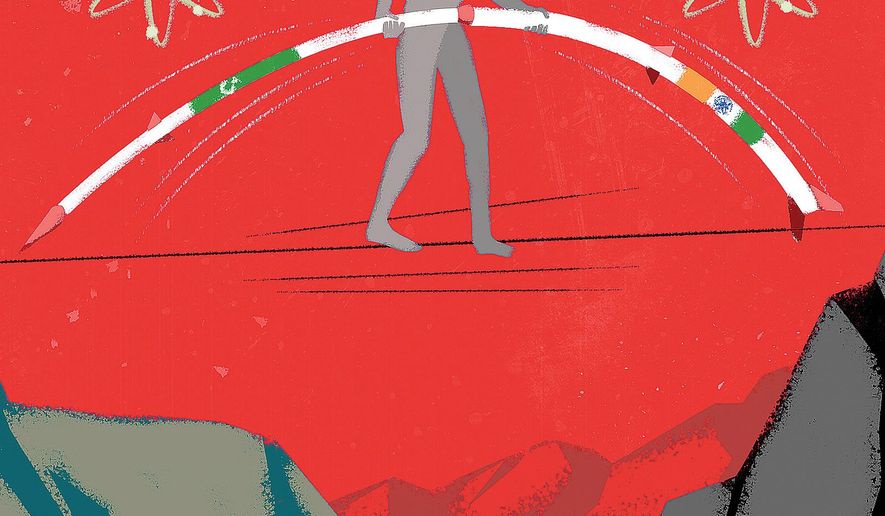OPINION:
The war between India and Pakistan over the possession of Kashmir simmers constantly but doesn’t boil. It flames but doesn’t explode for one overarching reason: Both nations have nuclear weapons and the means to deliver them. India and Pakistan have concluded that, although their peoples and leaders obsess over Kashmir, control over the region isn’t worth a nuclear war between them.
The latest flare-up came as a result of a February 14 terrorist suicide bomb attack that killed 40 Indian soldiers in Kashmir. Twelve days later India launched air strikes on a camp of the suspected terrorist group, Jaish-e-Mohammed in Pakistani territory. (JeM is one of the many terrorist networks that Pakistan supports and provides safe harbor.)
Pakistan shot down at least one Indian fighter and later returned its pilot. It also arrested 44 suspected JeM members, including the brother of Masood Ashar, the JeM leader. At that point, both sides de-escalated the fight.
This war began when British colonial rule of India ended in 1947. In the partition of what the colonialists called the Indian Subcontinent, Hindu-majority India was separated from two Muslim areas called Pakistan, one in the west and one in the east (now the country of Bangladesh).
In the northwest, between Pakistan and India, lies the region of Jammu and Kashmir, generally referred to as, simply, Kashmir. It became an Indian state under an agreement with its then-ruler, an Indian rajah. Pakistan disputed Kashmir’s accession to India, and the two have been at war over it ever since.
Neither nation has clean hands in this conflict. Kashmir, which has a population of more than 14 million people, is about 60 percent Muslim. India has refused to allow a plebiscite to enable Kashmiris to choose whether to be part of India or Pakistan. After a summer of bloody riots in 2016, India began direct rule over Kashmir enforced by a large troop presence.
Pakistan, having fought three stalemated wars with India for Kashmir, turned to supporting terrorist attacks against India.
The deadliest attack, perpetrated by Lashkar-e-Taiba (LeT) terrorists, was the 2008 Mumbai attack. At least 174 people were killed and more than 300 wounded.
Twice since 1947 the India-Pakistan war grew into major conflicts, the last in 1999, the year both became nuclear powers. Since then, both nations have been deterred from major conflict by their adversaries’ nuclear arsenals.
The resulting balance of power between India and Pakistan remains stable despite actions by each nation that would have, in the absence of nuclear weapons, probably led to all-out war.
India, which has a much larger army, is believed to have conventional superiority. However, both nations have significant arsenals of short-, medium- and long-range ballistic missiles, many of which can carry nuclear warheads. In the early 2010s, India’s government had intended to acquire stealth fighters. That purchase could have upset the balance of power, but India cancelled that plan because of funding concerns.
India has an assortment of surface combatant ships as does Pakistan. But India has also has had, since about 2012, a ballistic missile submarine capable of attacking from a great distance. This is clearly a strategic weapon that could be used in a first-strike on Pakistan. India’s deployment of that sub significantly tilted the balance of power toward India. But Pakistan didn’t risk nuclear war over it.
Pakistan has five attack submarines and may purchase six more from China. India already has about seven older subs and one nuclear-powered attack boat. But India has just leased a very fast nuclear-powered “Akula” class attack boat from Russia, to be delivered in 2020. It is also purchasing Russian S-400 anti-aircraft/anti-missile systems. Both can be regarded as strategic weapons but haven’t — so far — been regarded by the Pakistanis as sufficient to destroy the deterrent effects of their nuclear missile forces.
Pakistan has engaged in nuclear proliferation — through the former A.Q. Khan network, which sped North Korea’s nuclear weapons development — and missile development with the help of nations such as China. It is developing and deploying intermediate-range ballistic and cruise missiles which pose a massive threat to India. The balance of power, while shaky, apparently remains undisturbed.
From these facts, we have to conclude that the nuclear balance of power between India and Pakistan has created a high level of tolerance of each other’s hostile actions. Nevertheless, because there is no guarantee against an Indian-Pakistani nuclear war over Kashmir or something else, we must draw two additional conclusions.
The first conclusion is that, given the examples of the 2008 Mumbai terrorist attack and India’s February airstrikes into Pakistan, both nations are — so far — calibrating their hostile actions to avoid overcoming the effect of mutual deterrence. Neither has launched even conventionally-armed medium- or long-range ballistic missiles at the other, knowing that such a launch could be mistaken for a nuclear attack.
The second and most obvious conclusion is that both nations’ nearly continuous acquisition of advanced weapons — constrained only by funding limitations — means that their future conventional wars will grow deadlier and, as a result, create greater risk that the nuclear threshold could be crossed.
The India-Pakistan war over Kashmir will continue to simmer and occasionally flare. How long the two can avoid a nuclear conflict depends entirely on fallible human judgment. Not that it should be otherwise.
• Jed Babbin, a deputy undersecretary of Defense in the George H.W. Bush administration, is the author of “In the Words of Our Enemies.”




Please read our comment policy before commenting.